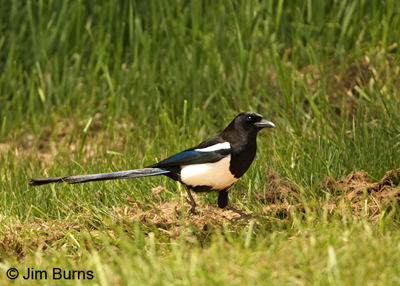
Years ago a colleague in Seattle regaled us with tales of the pet Black-billed Magpie raised by her family in a rural area of Eastern Washington when she was growing up. The best stories, of course, were about teaching it to mimic the human voice—to talk. Though there is no mention in Birds of North America about this ability, the species is well known in both Eurasia and North America for being boisterous, inquisitive, and smart . . . like most of the corvid tribe.
We first became aware of magpies, our “Lifers,” crossing the plains of western Kansas on our way to annual camping and backpacking trips in Colorado, and they quickly became for us a symbol of our escape from the humid flatlands into the crisp, dry confines of the spectacular Rocky Mountains. Black-billed Magpies are a Great Basin species, inhabiting the foothills and intramontane valleys of sixteen western states, but they are no longer seen regularly in northeast Arizona, perhaps another indicator of “global warning,” a metaphor serendipitously suggested by fat fingers on the keyboard.
Shrub-steppe niche specialists, conspicuous by their size, black, white, and iridescent plumage, and long tails, Black-billed Magpies were discovered by Lewis and Clark to be an essential element of the North American frontier, scavengers who followed the nomadic Native American tribes on their buffalo hunts, cleaning up the gut piles and picking the bones at kill sites. As the West was settled, magpies remained and adapted to new hosts, becoming so large in frontier life and lore that they entered the vernacular as synonyms for people who hoard worthless things and people who chatter constantly.
For humans these are pejorative descriptives, but they render the magpies an endlessly fascinating species. We have watched magpies raid garbage dumps and unattended picnic sites. We have watched magpies mob flying raptors and rob feeding raptors. We have watched a magpie “funeral,” a dozen or more answering the call of one having discovered a dead member of the tribe—flying in calling loudly, dropping down to examine the corpse, circling it, pecking at it, then leaving en masse.
Because they have passed researchers’ “mirror tests,” magpies are thought to be self-aware. They have large brains. Placed before a mirror, they will look behind the mirror, then watch in the mirror as they lift their feet and maneuver their tails. This summer in Alaska we saw a pair teaching two juveniles how to search for and extract worms from the mud at the edge of a marsh. And later, in Oregon, amidst smoke and ashes, we saw magpies follow and forage behind a herd of wild Kiger mustangs—just like back in their day.
I love broken country, open country in the mountains, peaks on the horizon, riparian corridors through meadows running random through forests of aspen and pine. Southwestern Colorado. Northeastern California. Yellowstone and Alaska of course. This is magpie country. If it were to happen or could be arranged I would be laid to rest, ashes, bones, whatever, surrounded by magpies, a fitting wilderness interment squad, strutting and chatting, inquisitive and busy.